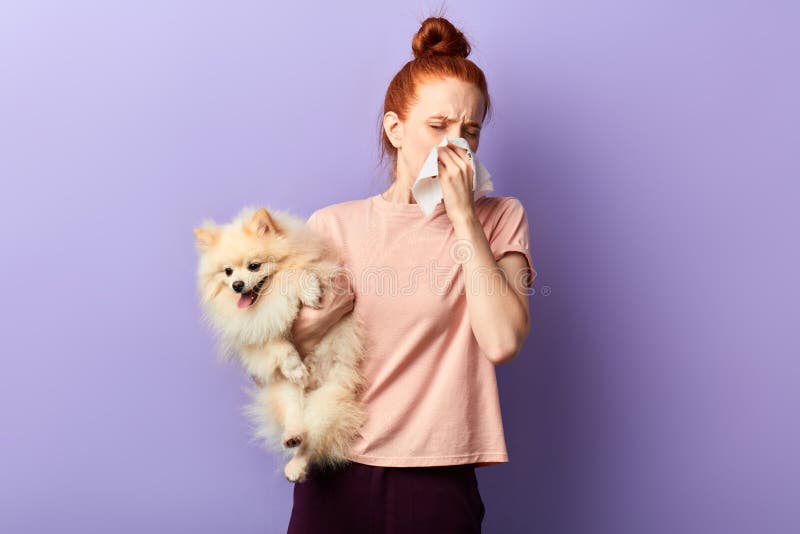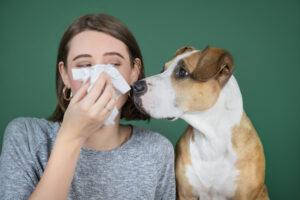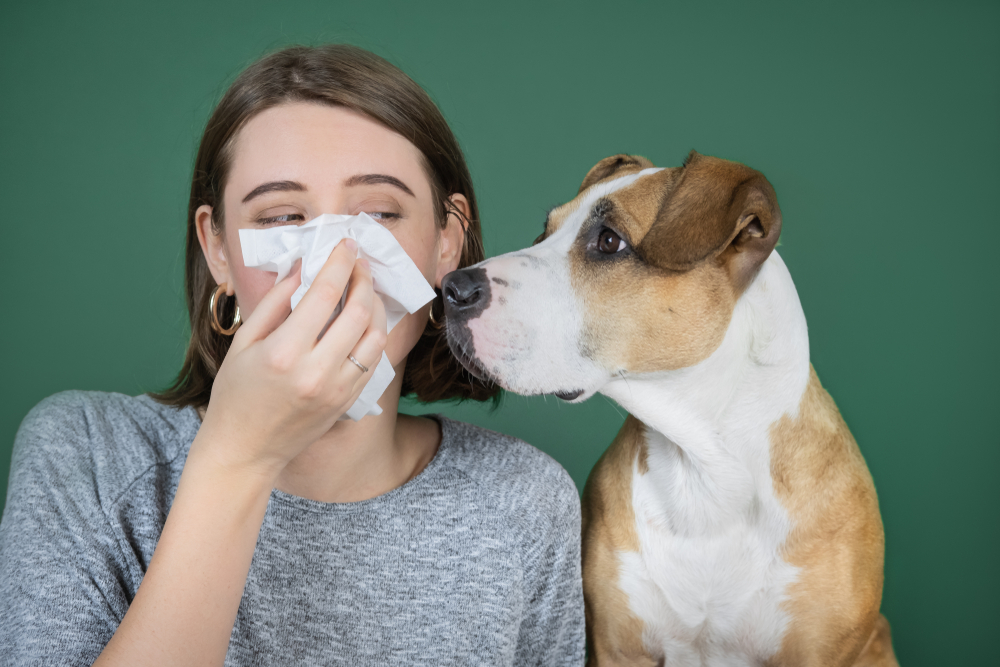LifeWithMyDogs is supported by our audience. When you purchase through one of our links, we may earn a small affiliate commission. As an Amazon Associate I earn from qualifying purchases. Your cost is not affected.
**********
When You Are Allergic to Dogs, Symptoms Seem Impossible to Manage
You can have a happy, healthy life with your dogs, even if you or a family member are allergic, symptoms can usually be managed.. With some careful planning, you can live a normal life, despite being allergic to dogs.

Allergic to Dogs Symptoms
Millions of people enjoy sharing their homes and their lives with pets, even those who are allergic to animals. Sadly, some people believe that if they have a pet allergy, they have no choice but to live without a fur friend.
Thankfully, there are many solutions that allow allergy sufferers to keep their beloved pets while successfully controlling their allergies. You’d be surprised to know how many people with allergies that aren’t life-threatening live happily with their pets.
In many cases, the benefits of having a pet outweigh the drawbacks of pet allergies. Our tips help make that more possible.
One of my sisters has found this to be true. An avid dog enthusiast, she has found many ways to help manage her allergy symptoms and still keep her dogs in her home.
Understand your Pet Allergies
Most doctors advise testing to determine what types of allergies you actually have. It is possible that you are not allergic to your pet but rather the culprit is something entirely different. Some people find the problem comes from the pollens that the dog has rolled in or even the type of shampoo used on your dog. A simple allergy test confirms what causes the allergic response, allowing you to take needed action.
If the test shows the allergens are from the pet, itself, it often is the saliva or dander, rather than the dog, that is triggering your allergic response. Simply put, the allergy response is the immune system responding to a substance. It is “reacting” as if the substance is harmful. You can read more about general allergy responses at the MayoClinic.
Reduce the Potential for Allergic to Dogs Symptoms
The problem intensifies when the dog is kept in the home due to the dander being scattered about on furniture, floors, and even walls. Even if the dog is kept in one room or outside, you might carry some of the dander on your clothing and shoes.
Each person’s response is individual. One person might show mild allergies such as runny nose and sneezing. In another person, the allergies might trigger a life-threatening asthma attack. And the reaction often worsens when multiple allergens are involved, such as pollens, cigarette smoke, and mold.
Additionally, an individual may find that they react differently to one dog or another. Often, the softer, shorter coats create fewer problems than a long, thick coat. However, this might be a case where the shorter coat is holding less dander than the thick, long coat.
In my sister’s case, all dogs trigger a reaction, until she lives with them for some time. She, like many people, is able to develop some resistance to a specific dog’s dander. Although she still has a response, it lessens over time, allowing her to enjoy her fur-kids in her life.
Some breeds of dogs are known as hypoallergenic and may be referred to as “non-allergenic” dogs. To be truthful, they still harbor dander and can trigger an immune response allergy. But often the response is less intense and more easily managed with proper grooming.
Top 5 Tips for Managing Allergic to Dogs Symptoms

If you are allergic to your dog, but your response isn’t life-threatening, there are many ways to proceed. You need to reduce indoor allergens to help relieve allergy symptoms. This allows you and your pet the ability to live together more comfortably.
If you or a family member’s allergic to dogs symptoms are uncomfortable, but not life-threatening, use these five steps to reduce the symptoms:
1. Create a Safe Zone in your Home
Preferably the allergic person’s bedroom—and limit or prohibit the pet’s access to it. This one varies on the person. Many people cannot imagine not sharing their room with a beloved pet. In this case, use mattress covers, sheets, and pillowcases that are impermeable. You will also need to clean your room frequently. Use a high-efficiency HEPA air cleaner in the room at all times. Remember to change the filter on a regular schedule, too.
2. Use HEPA Air Cleaners
Throughout the rest of the home, too. Consider choosing non-cloth curtains and blinds and make sure they are cleaned frequently. Avoid carpeting, opting instead for tile or wood which cleans more easily and completely. Carpeting catches everything and most doctors recommend people with allergies avoid its use, even if the home is not shared with pets. Clean your home frequently and thoroughly, being sure to remove dust and dander. Wash articles such as couch covers and pillows, curtains, and pet beds frequently, too.
3. Bathe your Pet on a Weekly Basis
Just as we shed our old skin cells, so do our beloved pets. This dander is what actually causes the allergic to dogs symptoms that we experience. Keeping your pet well-groomed and clean greatly reduces allergy problems. Please, you should use a shampoo intended for dogs to ensure it is pH balanced and safe for them. If you cannot bathe your pet yourself, ask a trusted family member to help. You might also find a local groomer willing to provide the grooming service on a weekly basis for a reduced fee.
In addition to the weekly baths, your pet needs to be kept brushed and free of any debris. If brushing exasperates your allergic to dogs symptoms, ask a family member or friend to help.
4. Don’t Be Quick to Blame your Dog for your Allergies
Ask your doctor to specifically test for allergies to pet dander. Many people with allergies are sensitive to more than one allergen. If you are one of them, you need to reduce the exposure to each of the causes, not just to your pet’s dander.
5. Ask your Doctor About Treatments
Additional remedies for allergies to dogs and other pets include immunotherapy (such as allergy shots), steroidal and antihistamine nose sprays, and antihistamine pills. Make sure your allergist understands your commitment to living with your pet. Using a combination of approaches—medical control of symptoms, good housecleaning methods, and immunotherapy—is most likely to succeed in allowing an allergic person to live with pets.
You will be glad that you didn’t let your allergic to dogs symptoms break up a beautiful relationship between you and your dog.
It is worth it to preserve the bond between you and your pet by checking if you are truly allergic to your pet and, if you are, to try these solutions. Join the large number of animal lovers who manage their allergies and live happily and healthily with their beloved pets.
Read More
Did You Know…

Allergic to Dogs


